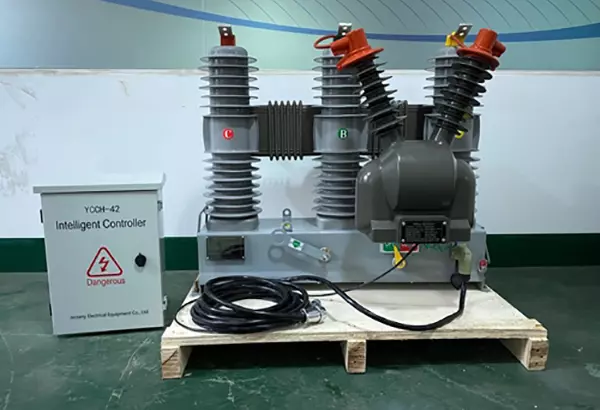Quick Solutions To Common Problems Of Vacuum Circuit Breakers
2022-08-15
2020-10-15
So today we will explain to you, if there is a problem with the vacuum circuit breaker, how should we quickly handle and solve it?

A.The vacuum circuit breaker fails to open
According to the different causes of the failure, the following failure phenomena exist:
1. The circuit breaker cannot be opened remotely;
2. Can not be opened manually on the spot;
3. The relay protection will act in the event of an accident, but the circuit breaker cannot be separated.
Cause Analysis:
1. The opening operation circuit is disconnected;
2. The opening coil is broken;
3. The operating power supply voltage is reduced;
4. The resistance of the opening coil increases and the opening force decreases;
5. The opening ejector rod is deformed, there is a jam phenomenon when opening, and the opening force is reduced;
6. The opening ejector rod is severely deformed and stuck when opening.
Failure hazards:
If the opening failure occurs in an accident, it will cause the accident to leapfrog and expand the scope of the accident.
Approach:
1. Check whether the opening circuit is disconnected;
2. Check whether the opening coil is disconnected;
3. Measure whether the resistance value of the opening coil is qualified;
4. Check whether the opening ejector rod is deformed;
5. Check whether the operating voltage is normal;
6. Change the copper opening ejector rod to steel to avoid deformation.
Precaution:
If the on-site electrician finds that the opening/closing indicator does not light up, they should check whether the opening/closing circuit is disconnected; the maintenance personnel should pay attention to measuring the resistance of the opening coil and check whether the opening ejector rod is deformed; If the material of the opening mandrel is copper, it should be replaced with steel; a low-voltage opening and closing test must be carried out to ensure the reliable performance of the circuit breaker.
B.The spring operating mechanism closing energy storage circuit failure
Trouble phenomenon:
1. The opening operation cannot be realized after closing;
2. The energy storage motor does not stop running, and even causes the motor coil to overheat and damage.
Cause Analysis:
1. The installation position of the limit switch is lowered, so that the closing spring has not been fully charged, the limit switch contact has been converted, the motor power supply has been cut off, and the energy stored in the spring is not enough for opening operation;
2. The installation position of the limit switch is on the upper side, so that after the closing spring is charged, the limit switch contact has not been converted, and the energy storage motor is still in working condition;
3. The limit switch is damaged and the energy storage motor cannot be stopped.
Failure hazards:
In the case that the energy storage is not in place, if the line has an accident and the circuit breaker refuses to open, it will cause the accident to leapfrog and expand the scope of the accident; if the energy storage motor is damaged, the vacuum switch cannot be opened and closed.
Approach:
1. Adjust the position of the limit switch to realize the accurate power off of the motor;
2. If the limit switch is damaged, it should be replaced in time.
Precaution:
During the switching operation, the operator should pay attention to the closing energy storage indicator to judge the closing energy storage situation; the maintenance personnel should perform 2 opening and closing operations on the spot to confirm that the circuit breaker is in good condition.
C.Different periods of opening and closing, large bounce value
Trouble phenomenon:
This fault is a hidden fault, and the relevant data must be obtained through the measurement of the characteristic tester.
Cause Analysis:
1. The mechanical performance of the circuit breaker body is poor. After multiple operations, the bounce value is too large due to different periods due to mechanical reasons;
2. Due to the large distance between the operating rods of the split type circuit breaker, when the opening force is transmitted to the contacts, there is a deviation between the phases, resulting in different periods and large bounce values.
Failure hazards:
If the period is different or the bounce is large, it will seriously affect the ability of the vacuum circuit breaker to break the overcurrent, affect the life of the circuit breaker, and cause the circuit breaker to explode in severe cases. Because this fault is a hidden fault, it is more dangerous.
Approach:
1. Under the premise of guaranteeing the stroke and overtravel, adjust the length of the three-phase insulation rod to make the synchronization and bounce test data within the qualified range;
2. If it cannot be achieved through adjustment, the vacuum bubble of the data unqualified phase must be replaced and readjusted to the data qualified.
D.The vacuum degree of the vacuum bubble is reduced
Trouble phenomenon:
The vacuum circuit breaker interrupts the current and extinguishes the arc in the vacuum bubble, and the vacuum circuit breaker itself does not have a device for qualitatively and quantitatively monitoring the characteristics of the vacuum degree, so the vacuum degree reduction fault is a hidden fault, and its degree of danger is far greater than the dominant fault .
Cause Analysis:
The main reasons for the reduced vacuum degree are as follows:
1. There are problems with the material or production process of the vacuum bubble, and the vacuum bubble itself has small leaks;
2. There are problems with the material or production process of the corrugated tube in the vacuum bubble, and there are leaks after repeated operations;
3. Split type vacuum circuit breaker, such as the vacuum circuit breaker using electromagnetic operating mechanism, during operation, due to the relatively large distance of the operating link, it directly affects the characteristics of the switch's synchronization, bounce, over-travel, etc., so as to speed up the reduction of vacuum degree.
Failure hazards:
The reduction of the vacuum degree will seriously affect the ability of the vacuum circuit breaker to break the overcurrent, and cause the service life of the circuit breaker to drop sharply. In severe cases, the switch will explode.
Approach:
1. When the circuit breaker is regularly powered off for maintenance, a vacuum tester must be used to qualitatively test the vacuum degree of the vacuum bubble to ensure that the vacuum bubble has a certain degree of vacuum;
2. When the degree of vacuum decreases, the vacuum bubble must be replaced, and characteristics such as stroke, synchronization, and bounce must be tested.
Precaution:
1. When selecting vacuum circuit breakers, mature products produced by reputable manufacturers must be selected;
2. Choose a vacuum circuit breaker integrated with the main body and the operating mechanism;
3. During the inspection, the operator should pay attention to whether there is any discharge outside the vacuum bubble of the circuit breaker. If there is a discharge, the vacuum degree test result of the vacuum bubble is basically unqualified, and the power should be replaced in time;
4. When the maintenance personnel conduct power outage maintenance work, they must conduct characteristic tests such as synchronization, bounce, stroke, over travel, etc. to ensure that the circuit breaker is in good working condition.
For more information, please visit the website: www.jecsany.com




